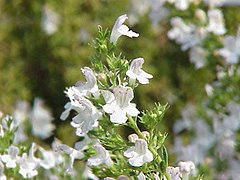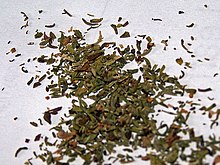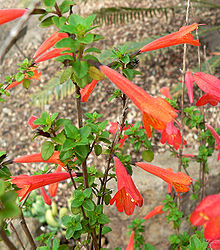Satureja
| Savory | |
|---|---|

| |
| Winter Savory (Satureja montana) | |
| Scientific classification | |
| Kingdom: | |
| Division: | |
| Class: | |
| Subclass: | |
| (unranked): | |
| Order: | |
| Family: | |
| Genus: | Satureja |
| Species | |
|
About 30, see text | |
Satureja is a genus of aromatic plants of the family Lamiaceae, related to rosemary and thyme. There are about 30 species called savories, of which Summer Savory and Winter Savory are the most important in cultivation.
Description
Satureja species are native to warm temperate regions and may be annual or perennial. They are low-growing herbs and subshrubs, reaching heights of 15-50 cm.
The leaves are 1 to 3 cm long, with flowers forming in whorls on the stem, white to pale pink-violet.
Ecology and cultivation
Satureja species are food plants for the larva of some Lepidoptera. Caterpillars of the moth Coleophora bifrondella feed exclusively on Winter Savory (S. montana).
Savory may be grown purely for ornamental purposes; members of the genus need sun and well-drained soil.
Uses

Both summer savory and winter savory are used to flavor food. The former is preferred by cooks but as an annual is only available in summer; winter savory is an evergreen perennial.
Savory plays an important part in Italian cuisine, particularly when cooking beans. It is also used to season the traditional Acadian stew known as fricot.
Yerba Buena (Spanish: "good herb"; S. douglasii) is used to make a herbal tea in the western United States.
Winter savory is reputed to help ease flatulence.
Selected species

- Satureja acinos
- Satureja alpina
- Satureja coerulea
- Satureja cuneifolia
- Satureja douglasii – Yerba Buena (syn. S. chamissonis)
- Satureja hortensis – Summer Savory
- Satureja mexicana
- Satureja montana – Winter Savory
- Satureja multiflora – Chilean Shrub Mint
- Satureja palmeri (believed extinct; rediscovered 2001)
- Satureja rumelica
- Satureja spicigera
- Satureja thymbra
- Satureja viminea – Serpentine Savory
Formerly in Satureja
- Browne's Savory, Clinopodium brownei (as Satureja brownei)
- Large-flowered Calamint, Calamintha grandiflora (as Satureja grandiflora)
- Stone Mint, Cunila mariana (as Satureja origanoides)
See also
